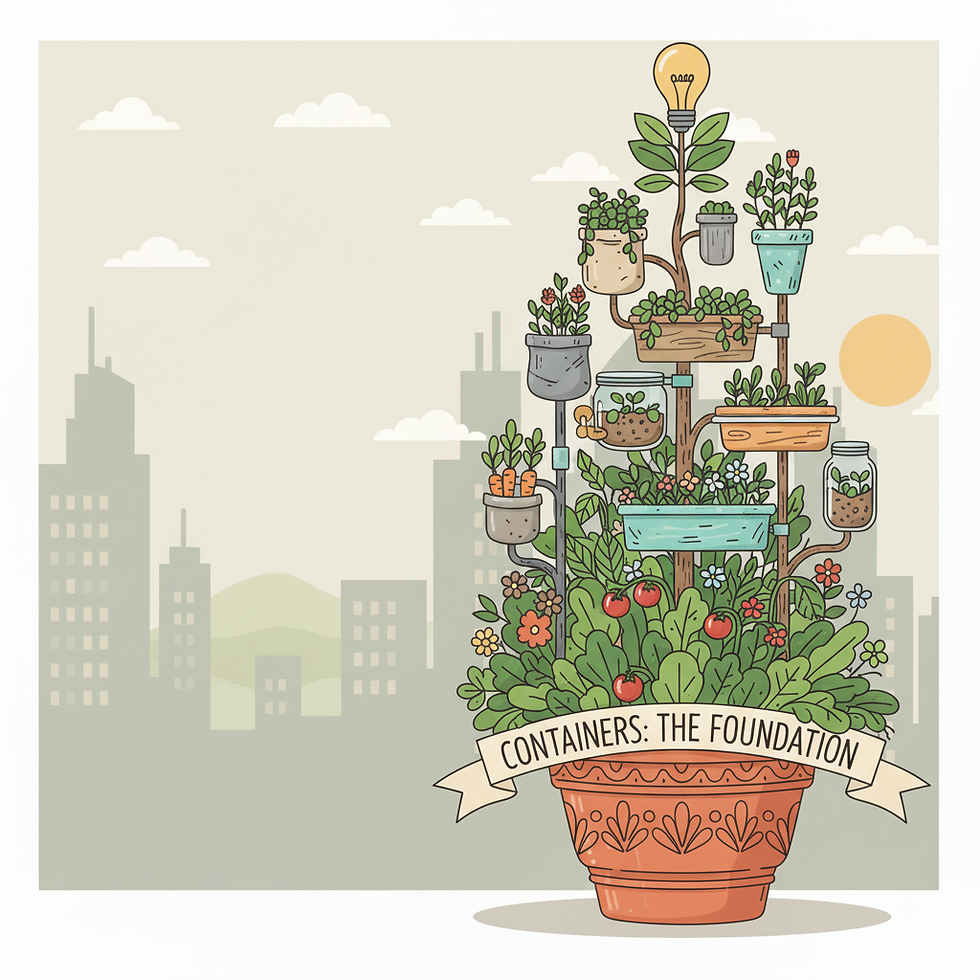Small Space Gardens. Cultivating Abundance in Every Inch.
- Jonathan Valencia

- Sep 30
- 7 min read
Updated: Oct 3

Imagine a vibrant oasis bursting with fresh produce, fragrant herbs, and beautiful blooms – all within the confines of a tiny patio, a narrow balcony, or even a sunny wall. For many aspiring gardeners, the dream of a lush garden seems confined by the harsh reality of limited space.
But what if we told you that your gardening dreams don't need sprawling acres to flourish? Welcome to the revolutionary world of small-space and vertical gardening, where innovation and creativity transform even the most modest nooks into productive and breathtaking green sanctuaries.
In an increasingly urbanized world, where concrete jungles often replace open fields, the desire to connect with nature and grow our own food has never been stronger. This longing has fueled a spectacular surge in ingenuity, giving rise to methods that defy traditional gardening norms. Small-space and vertical gardening aren't just trends; they are sustainable, efficient, and incredibly rewarding solutions for anyone who believes that a lack of land shouldn't mean a lack of garden.
This comprehensive guide will delve into the exciting realm of cultivating upwards and outwards, exploring everything from clever container strategies to gravity-defying vertical systems. We’ll uncover the secrets to maximizing every square inch, transforming overlooked spaces into bountiful havens, and bringing the joy of gardening to everyone, everywhere.
The Small-Space Garden Revolution: Making Every Inch Count

Small-space gardening is more than just downsizing; it's a philosophy of intentional design and efficient resource utilization. It’s about understanding the unique constraints of your environment and turning them into opportunities.
Whether you have a compact balcony, a sunny windowsill, a cozy patio, or even just a small corner of your yard, these techniques empower you to grow a surprising amount of food and flowers.
Containers: The Foundation of Compact Cultivation

Containers are the bedrock of small-space gardening. They offer unparalleled flexibility, allowing you to move plants to optimize sunlight, protect them from harsh weather, or simply rearrange your garden's layout. But not all containers are created equal, and smart choices can significantly impact your success.
Choosing the Right Pot:
Size Matters: The general rule is: the bigger, the better. Larger pots hold more soil, retain moisture longer, and provide more room for root development, leading to healthier, more productive plants. Even for seemingly small plants, opt for a slightly larger pot than you think you need.
Material Considerations:
Terracotta/Clay: Breathable and attractive, but can dry out quickly, especially in hot climates. Ideal for plants that prefer drier conditions.
Plastic: Lightweight, inexpensive, and retains moisture well. Choose durable, UV-resistant plastic to prevent degradation.
Fabric Grow Bags: Excellent for aeration and drainage, preventing root circling. They are lightweight and easy to store when not in use. Perfect for potatoes, carrots, and leafy greens.
Wood: Visually appealing and offers good insulation. Ensure it's treated for outdoor use and lined to prevent rapid decay.
Drainage is Non-Negotiable: Regardless of material, every container must have drainage holes to prevent waterlogging, which can quickly kill plants.
Smart Plant Selection for Containers:
Dwarf and Compact Varieties: Many popular vegetables and fruits now come in compact or "patio" varieties specifically bred for containers. Look for dwarf tomatoes, bush cucumbers, miniature eggplants, and compact peppers.
Root Vegetables: Carrots, radishes, and smaller potato varieties thrive in deeper containers.
Leafy Greens: Lettuce, spinach, kale, and Swiss chard are excellent choices, offering continuous harvests.
Herbs: A container herb garden is a must-have, providing fresh flavors just steps away from your kitchen.
Berries: Strawberries, blueberries (in acidic soil), and dwarf raspberry varieties can be very successful in pots.
Going Up: The Wonders of Vertical Gardening

When horizontal space is a luxury you don't have, the only way to go is up! Vertical gardening is a game-changer, transforming walls, fences, and railings into verdant, productive surfaces. It’s not just about aesthetics; it’s about maximizing yield, improving air circulation, and even cooling surrounding areas.
Vertical Gardening Systems: A Glimpse into the Future
The ingenuity in vertical gardening systems is truly inspiring, offering solutions for every budget and skill level.
Stacked Planters & Tiered Gardens:
These systems consist of multiple pots or trays stacked one above the other, often rotating to ensure even sunlight. They are fantastic for strawberries, herbs, and leafy greens, allowing you to grow a diverse array of plants in a small footprint.
Advantages: Efficient use of ground space, relatively easy to set up, good for small plants.
Considerations: Lower tiers might receive less light, requiring rotation.
Wall-Mounted Planters & Pockets:
This category includes a vast range of options, from individual pots mounted on a frame to fabric pocket systems that create a "living wall."
Pallet Gardens: Repurposed wooden pallets can be easily transformed into vertical planters by attaching landscape fabric to create pockets for soil. They offer a rustic, DIY charm.
Rain Gutter Gardens: Old rain gutters can be cleaned, sealed, and mounted to a wall or fence, perfect for shallow-rooted plants like lettuce, radishes, and herbs.
Fabric Pocket Planters: These lightweight systems have multiple individual pockets that can be filled with soil and plants. They are excellent for herbs, small flowers, and strawberries, and are often very affordable.
Modular Systems: Many companies offer interlocking or stackable modular units that allow you to customize the size and shape of your vertical garden.
Advantages: Transforms blank walls into living art, highly customizable, improves air circulation around plants.
Considerations: Requires sturdy mounting, watering can be tricky (upper plants drain onto lower ones), potential for faster drying.
Trellises & Obelisks: The Classic Climbers' Support
While not strictly "systems" in the modern sense, trellises, arbors, and obelisks are fundamental vertical gardening tools. They provide essential support for climbing plants, guiding them upwards and maximizing vertical growing space.
Ideal for: Tomatoes (determinate varieties can be caged, indeterminate need strong support), cucumbers, pole beans, peas, vining squash, small melons, and climbing flowers like morning glories.
Advantages: Simple, effective, encourages air circulation, keeps fruit off the ground.
Considerations: Needs to be robust enough to support mature plant weight.
Hydroponics & Aeroponics: The Future of Soilless Vertical Farming

For the truly space-constrained or tech-savvy gardener, hydroponics and aeroponics offer cutting-edge solutions for vertical cultivation without soil. These methods use nutrient-rich water solutions to deliver everything plants need directly to their roots.
Hydroponics: Plants grow with their roots immersed in a nutrient solution or in an inert growing medium (like rockwool or coco coir) that is periodically irrigated. Vertical hydroponic towers are becoming increasingly popular for growing leafy greens and herbs.
Aeroponics: An even more advanced method where plant roots are suspended in air and misted with a nutrient solution. This is incredibly efficient in terms of water and nutrient use, and can lead to faster growth.
Advantages of Soilless Systems:
Faster Growth & Higher Yields: Plants often grow more quickly and produce more due to direct nutrient access.
Water Efficiency: Uses significantly less water than traditional soil gardening.
No Weeds or Soil Pests: Eliminates common gardening headaches.
Space-Saving: Perfect for indoor vertical setups, often integrated with LED grow lights.
Considerations: Requires a higher initial investment, more technical knowledge, and careful monitoring of nutrient levels.
Maximizing Your Micro-Garden: Key Strategies for Success
Regardless of the system you choose, successful small-space and vertical gardening relies on a few core principles:
Sunlight is Paramount:
Observe Your Space: Track how much direct sunlight your chosen area receives throughout the day. Most vegetables need at least 6-8 hours of direct sun. Leafy greens and many herbs can tolerate 4-6 hours.
Reflective Surfaces: White walls or fences can reflect light, increasing its intensity for plants.
Mirrors: Strategically placed mirrors can bounce light into shady corners, but be careful not to scorch plants.
Watering Wisdom:
Containers Dry Faster: Soil in pots and vertical systems dries out much more quickly than in garden beds. Daily or even twice-daily watering may be necessary during hot, sunny periods.
Automate if Possible: Drip irrigation systems or self-watering containers can be lifesavers, ensuring consistent moisture and reducing daily chores.
Check Soil Moisture: Stick your finger 2 inches into the soil. If it feels dry, it's time to water.
Nutrient Nurturing:
Feed Regularly: With limited soil volume, plants quickly deplete nutrients. Use a balanced liquid fertilizer (organic options are available) every 2-4 weeks, following package directions.
Quality Potting Mix: Start with a high-quality, well-draining potting mix, not garden soil, which can compact in containers.
Strategic Plant Grouping (Companion Planting):
Benefits: Some plants benefit from growing near each other, deterring pests or improving growth. For example, marigolds can deter nematodes, and basil is said to improve tomato flavor.
Consider Growth Habits: Group plants with similar water and light requirements. Also, consider their mature size and avoid overcrowding.
Pest & Disease Management:
Vigilance is Key: In smaller spaces, it's easier to spot pests and diseases early. Inspect your plants regularly.
Organic Solutions: Use organic pest control methods like neem oil, insecticidal soap, or simply hand-picking pests.
Good Air Circulation: Vertical gardens often provide better air circulation, reducing fungal issues.
Succession Planting & Harvesting:
Continuous Harvests: Don't plant everything at once. Stagger your plantings every few weeks to ensure a continuous supply of fresh produce.
"Cut and Come Again" Varieties: For leafy greens and herbs, harvest the outer leaves, allowing the plant to continue producing from its center.
Inspiring Ideas for Your Own Micro-Farm

The Balcony Bistro Garden: Combine dwarf tomatoes, bush beans, a variety of herbs, and some trailing nasturtiums in attractive containers. Add a small trellis for cucumbers or pole beans.
The Kitchen Wall Herb Garden: Mount a series of small pots or a fabric pocket planter near your kitchen door or a sunny window for an endless supply of fresh herbs.
The Strawberry Tower: A stacked planter exclusively for strawberries provides a visually appealing and highly productive focal point.
The Salad Wall: Dedicate an entire wall or fence section to various types of lettuce, spinach, kale, and other salad greens using wall-mounted planters or rain gutters.
The Patio Fruit Paradise: Grow blueberries, dwarf citrus, and fig trees in large containers. Add trailing strawberries around the base.
The Ripple Effect: Beyond Just Growing Food
Small-space and vertical gardening offer far more than just fresh produce. They create a profound connection to nature, even in urban environments. They foster a sense of accomplishment, teach valuable lessons about sustainability, and can even become therapeutic escapes from the demands of modern life.
By embracing these innovative techniques, you’re not just growing plants; you’re cultivating resilience, fostering biodiversity, and transforming overlooked spaces into vibrant, life-affirming places. So, don't let a lack of land deter you. Look around your space, find that forgotten corner or blank wall, and start reaching for the sky. Your abundant, beautiful, and delicious garden awaits!































Comments